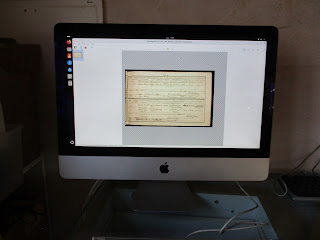Ebay (and Etsy) can be an
excellent research resource for finding resources and artefacts relevant to daily life in the late nineteenth and early twentieth century be they coins, postcards, old medicine bottles, they're all there.
And sometimes I browse ebay looking for, well I'm never quite sure .
Anyway, last night I came across this example of a
British field service postcard, a postcard issued to troops on the western front and elsewhere to send reassuring messages home.
Now if you look at it, you might be forgiven for thinking that the address was written in purple ink.
But it isn't, it's written in indelible pencil.
Pencil though has a problem.
It scuffs, meaning that if pages written in pencil rub together, the pencil script can rub off. In his book about his epic ride with Ella Maillart across China in the 1930s, the writer Peter Fleming complains that some of his notes were illegible after a few days riding as they'd been jogged in a saddle bag and he hadn't had time to write his notes up properly.
The
indelible pencil was designed to solve this problem by adding aniline dye, the chemical dye that gave Victorian ladies shimmering purple dresses, to the kaolin and graphite mix during pencil manufacture using the
Conté process.
This produced a pencil that provided a permanent scuff proof text. It was also mildly toxic, especially if you licked it to get a stronger colour, and possibly provides a
conservation challenge.
However copying or indelible pencils were used extensively during the first world war to complete paperwork and simply for messages home, because the hell of mud blood and filth in the trenches didn't really provide a suitable environment for writing with a nib pen, and as I've said pencil scuffs, making it no use in an environment where the papers could have been roughly handled.
A further search of ebay turned up other examples of world war 1 postcards written in indelible pencil, and not just British examples, the Germans used
them in both world war 1 and 2, for much the same reason as the British, to provide a means of writing that was reasonably permanent and could not be changed easily. In fact some countries still require the use of indelible pencils in elections to minimise the risk of vote tampering.
However, for most purposes the indelible pencil was replaced by the cheap ballpoint pen by the mid 1950s, except for a few specialist purposes such as being used by dentists to mark up dental casts, but they are still produced and reasonably easy to get hold of.
While I never used one in my short career as a field ecologist I can see that they'd still be useful scribbling observations in the rain and damp.
And I must admit to a "Proust and madeleine" style moment when I first came across the field postcard example above.
I remembered my Uncle Dave using one to complete his vehicle log book some time around 1960.
I'm not sure when my uncle Dave had been born, I havn't traced that part of my family history yet, but he must have been born while Queen Victoria was still on the throne. (My father was the youngest of ten, and I once worked out that when he was born there was still a Kaiser in Germany, one in Vienna, and (only for a few days more) a tsar in Petersburg, not to mention a Sultan in Constantinople. When he died at the great age of 98 all these were long gone.)
Anyway, my father's eldest sister married my uncle Dave.
With classic bad timing, Dave had signed on in 1913 as a private soldier in the artillery on the basis of his skill with horses and horse gear.
He survived the first world war, learned to drive a truck, and got a job as a chauffer - there are photographs of him in the 1920s in a peaked cap and leather gloves standing beside some big black car - with the Co-operative Funeral Service driving hearses and funeral cars, as well as driving members of the nobocracy to the grouse shooting and their summer houses - he claimed to have once driven
JP Morgan junior, and been tipped five pounds by him because he had to wait while Morgan finished a meeting that ran well over time.
How true the story is I don't know, but it's certainly not impossible
I don't remember him driving any of the big black funeral cars, but I do remember him driving a green electric laundry van.
My guess is that in the run up to retirement, he had been given an easier job by the Co-op, driving a laundry truck picking up and dropping off laundry at hotels and the like.
As I was a small child I don't remember the details, other than it was green and very quiet, I'm guessing it was based on
milk float style technology, but I do remember filling out a log book with a purple pencil and him licking it.
Strange what you sometimes remember...









